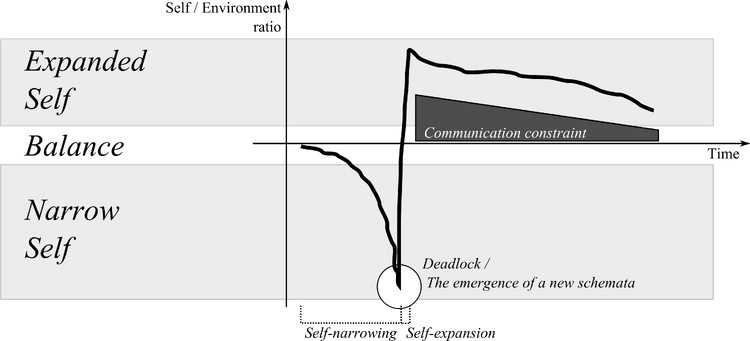| Line 1: | Line 1: | ||
=1. Introduction= |
=1. Introduction= |
||
| − | In presenting this model, I believe that it explains a great deal of some aspects of human behavior. The model describes diverse forms of human behavior – from religion to sex, and from problem solving to intimate relationships – with the help of just a few basic concepts. At the same time, its results are compatible with those of the determining psychological schools and sub-sciences – analytical, cognitive and social psychologies – and explain them in a broader context. It integrates the knowledge of human behavior found in common sense and world religions, with the science of psychology. I believe that the model manages to identify the key elements of human behavior, and so do not consider it an exaggeration to propose that this model be used as the conceptual framework of psychology. See the Appendix (page 188) in Miklos Fodor's book |
+ | In presenting this model, I believe that it explains a great deal of some aspects of human behavior. The model describes diverse forms of human behavior – from religion to sex, and from problem solving to intimate relationships – with the help of just a few basic concepts. At the same time, its results are compatible with those of the determining psychological schools and sub-sciences – analytical, cognitive and social psychologies – and explain them in a broader context. It integrates the knowledge of human behavior found in common sense and world religions, with the science of psychology. I believe that the model manages to identify the key elements of human behavior, and so do not consider it an exaggeration to propose that this model be used as the conceptual framework of psychology. See the Appendix (page 188) in Miklos Fodor's book [[http://www.psy2.org/index.php?n=Book.Download Self-expansion: a NEW! integrated paradigm for psychology]] for a formal description of the FIPP model. |
=2. Principal concepts= |
=2. Principal concepts= |
||
Revision as of 16:11, 8 December 2008
1. Introduction
In presenting this model, I believe that it explains a great deal of some aspects of human behavior. The model describes diverse forms of human behavior – from religion to sex, and from problem solving to intimate relationships – with the help of just a few basic concepts. At the same time, its results are compatible with those of the determining psychological schools and sub-sciences – analytical, cognitive and social psychologies – and explain them in a broader context. It integrates the knowledge of human behavior found in common sense and world religions, with the science of psychology. I believe that the model manages to identify the key elements of human behavior, and so do not consider it an exaggeration to propose that this model be used as the conceptual framework of psychology. See the Appendix (page 188) in Miklos Fodor's book [Self-expansion: a NEW! integrated paradigm for psychology] for a formal description of the FIPP model.
2. Principal concepts
FIPP operates with three known psychological concepts: Self, Environment and cognitive schemata. We redefine them as follows (henceforth the redefined concepts of Self and Environment are indicated with capitals):
- The Self is the essence of a person that perceives the Environment.
- Environment is what the Self perceives. As a part of the Environment, social Environment refers to that group of people which is important for the Self.
- Cognitive schemata are the basic elements of thought. By structurally modeling the outside world they assist in the perception of the Environment for the Self (similar to a translation of the physical world to mental elements). For example, these are the concepts, shapes, categories, and technologies. The formation of a new schema creates a new model of the Environment; using that new model, the Self is able to structure and perceive, control and react to its Environment.
The Self and its cognitive schemata are only partly comprehensible to others. Getting to know completely another person’s cognitive schemata is impossible, even those of people using well-defined, similar schemata. Interpersonal communication, usually conveys between people, compared with what they have in their mind, a simplified form of cognitive schemata.
The Environment is completely subjective, and accessible only to the Self that developed and uses it. It is partly free from physical reality, since it was created by the Self deciding what it wants to perceive from it, and what it does not.
The partial independence from physical reality described above does not contradict the Self trying to model, understand and adapt to the physical world by discovering its rules and relations with the help of cognitive schemata.
The Self perceives its own size in relation to that of the Environment, and the proportion of these helps to characterize the ever changing relationship of these two entities. In addition, the relationship of the Self and the Environment is a key issue, as it shows the effectiveness of the adaptation of the Self i.e. how much it is subject to the Environment.
3. The model
The model introduces two new concepts according to the relation-ship of the sizes of the Self and the Environment:

Self-narrowing
- Self-narrowing
- when the Self perceives the Environment as becoming increasingly larger, and itself becoming increasingly defenseless. The extreme is the demolition of the Self by the Environment.

Self-expansion
- Self-expansion
- when the Self manages to control the Environment, and so the Environment becomes part of the Self, enriching rather than threatening it. In this way, the Self becomes bigger than the Environment. At the extreme, we can imagine the Self exploding into the Environment and destroying itself.
These relationships are dynamic, and being subjective constructs they can scarcely be interpreted in numerical terms. The emphasis is on their relationship with each other, and on how the Self experiences its relationship with the Environment.
When the Self is narrowing, its energy continuously decreases. When the Self is expanding, its energy continuously increases.
3.1 The FIPP-pattern

FIPP-pattern
With the help of the concepts of Self-narrowing and Self-expansion we can characterize human behavior in the following pattern:
the establishment of a new cognitive schema changes the course of Self-narrowing and converts it into Self-expansion.
The new cognitive schema typically emerges from the integration of two or more incongruous cognitive schemata. The integration is a process whereby the old op-posing schemata fall into smaller pieces (into their individual cognitive schemata), and from these pieces a new schema arises that contains the major characteristic of the two previous - opposing - schemata. The new schemata is superior to the previous two. In plain language, the extremely narrow state of the Self just before the birth of the new cognitive schema is termed deadlock.
3.2 Supplement to the pattern: the imperative of communication
Following the establishment of the new cognitive schema, the Self expands only for a short time, as long as the Self does not hand on the new schema to its social Environment i.e. it is retained for itself. If the Self begins to spread the new cognitive schema, the Self continues to expand. During the process of expansion, energy is generated, which is used in disseminating the new cognitive schema.
4. Example
Let us imagine a person having some basic IT knowledge; how to switch on a computer, use a text editor, and to save and print the typed text. He then encounters a problem: any letter button pressed on the keyboard appears on the monitor only in upper-case letters. What then happens?
- He tries using all of his existing cognitive schemata – restarts the application, computer, et al – which could be relevant, but none of these works.
- He then asks himself, “That usually works fine, but now it does not. Am I doing something wrong?" He repeats the schemata many times without success.
- Deadlock comes: he is close to giving up, and consider his cognitive schemata regarding computers useless; "I hate stupid computers, and will use only pen and paper in future."
- He then begins to read the buttons on the keyboard and test the effect of the unknown ones. After pressing Caps Lock, then another letter…
- It works! "The solution is the Caps Lock key! It means capitals lock." Eureka feeling ensues: a new cognitive schema has been created!
- As he sees that it works, he feels:
- additional energy; and
- an urge to communicate this to those who can appreciate his previous efforts and can profit from his new cognitive schema.
- Using this additional energy, he begins to communicate; looking for friends, telling room-mates about the function of the new button etc.
- As he communicates so he feels increasingly happy, and the pride of owning and using a tool so that he can control his Environment (that part of his interest that he feels is important)
Principal points covered in this article:
- introducing the elements FIPP uses
- changing Self-narrowing into Self-expansion via new cognitive schema
- broadcasting that schema